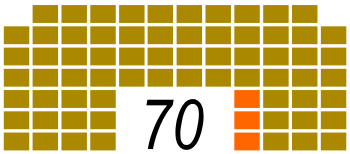Delhi Legislative Assembly
| Legislative Assembly of Delhi (Vidhan Sabha of Delhi) | |
|---|---|
 | |
| Type | |
| Type | |
Term limits | 5 years |
| Leadership | |
Speaker of the Assembly | |
Dy. Speaker | |
Leader of the House | |
Leader of the Opposition | |
Secretary |
Prasanna Kumar Suryadevara |
| Structure | |
| Seats | 70 |
 | |
Political groups | [3] |
Length of term | 5 years |
| Elections | |
| First-past-the-post | |
Last election | 7 February 2015[4] |
| Meeting place | |
| Old Secretariat , Delhi, India | |
| Website | |
| Legislative Assembly of Delhi | |
The Legislative Assembly of Delhi, also known as Delhi Vidhan Sabha, is a unicameral law making body of the National Capital Territory of Delhi, one of the 7 union territories in India. It is situated at Delhi, the state capital of Delhi, with 70 Members of the Legislative Assembly (MLA).
The seat of assembly is the Old Secretariat building, which is also the seat of the Delhi Government.
History
The Delhi Legislative Assembly was first constituted on 7 March 1952 under the Government of Part C States Act, 1951; it was inaugurated by Home Minister K. N. Katju. The Assembly had 48 members, and a Council of Ministers in an advisory role to the Chief Commissioner of Delhi, though it also had powers to make laws. The first Council of Ministers was led by Chaudhary Brahm Prakash, who became the first Chief Minister of Delhi.[5][6]
However, the States Reorganisation Commission, set up in 1953, led to the Constitutional amendment through States Reorganisation Act, 1956, which came into effect on 1 November 1956. This meant that Delhi was no longer a Part-C State and was made a Union Territory under the direct administration of the President of India. Also the Delhi Legislative Assembly and the Council of Ministers were abolished simultaneously. Subsequently, the Delhi Municipal Corporation Act, 1957 was enacted which led to the formation the Municipal Corporation.[5]
Then, in September 1966, with "The Delhi Administration Act, 1966", the assembly was replaced by the Delhi Metropolitan Council with 56 elected and five nominated members with the Lt. Governor of Delhi as its head. The Council however had no legislative powers, only an advisory role in the governance of Delhi. This set up functioned until 1990.[5][7]
This Council was finally replaced by the Delhi Legislative Assembly through the Constitution (Sixty-ninth Amendment) Act, 1991, followed by the Government of National Capital Territory of Delhi Act, 1991 the Sixty-ninth Amendment to the Constitution of India, which declared the Union Territory of Delhi to be formally known as National Capital Territory of Delhi and also supplements the constitutional provisions relating to the Legislative Assembly and the Council of Ministers and related matters.[8] The Legislative Assembly is selected for period of five years, and presently it is the sixth assembly, which was selected through the 2015 Legislative Assembly election.
Delhi Legislative Elections
The election campaigns have played a critical role in determining the outcome of elections in Delhi. This is particularly evident in elections since 2000.[9]
Elections to the Legislative Assemblies of Delhi were held in the following years:
- Delhi Legislative Assembly election, 1951
- Delhi Legislative Assembly election, 1993
- Delhi Legislative Assembly election, 1998
- Delhi Legislative Assembly election, 2003
- Delhi Legislative Assembly election, 2008
- Delhi Legislative Assembly election, 2013
- Delhi Legislative Assembly election, 2015
Assembly building
Originally built 1912, designed by E. Montague Thomas to hold the Imperial Legislative Council and subsequently the Central Legislative Assembly (after 1919), till the newly constructed Parliament House of India in New Delhi (Sansad Bhawan)was inaugurated on 18 January 1927.[5]
The building also housed in the Secretariat of the Government of India, and was built after the capital of India shifted to Delhi from Calcutta, the temporary secretariat building was constructed in a few months' time in 1912, it functioned as the Secretariat for another decade, before the offices shifted to the present Secretariat Building on Raisina Hill.[10]
List of Assemblies
| Assembly | Election Year | Political Party | Chief Minister |
|---|---|---|---|
| 1st Assembly | 1993 | Bharatiya Janata Party | Madan Lal Khurana Sahib Singh Verma Sushma Swaraj |
| 2nd Assembly | 1998 | Indian National Congress | Sheila Dikshit |
| 3rd Assembly | 2003 | Indian National Congress | Sheila Dikshit |
| 4th Assembly | 2008 | Indian National Congress | Sheila Dikshit |
| 5th Assembly | 2013 | Aam Aadmi Party | Arvind Kejriwal |
| President's rule | President's rule | Post Vacant | |
| 6th Assembly | 2015 | Aam Aadmi Party | Arvind Kejriwal |
See also
- First Legislative Assembly of Delhi
- Second Legislative Assembly of Delhi
- Third Legislative Assembly of Delhi
- Fourth Legislative Assembly of Delhi
- Fifth Legislative Assembly of Delhi
- Sixth Legislative Assembly of Delhi
References
- ↑ http://www.hindustantimes.com/delhi/rakhi-birla-set-to-be-next-deputy-speaker-of-delhi-assembly/story-yd3s3Bn97wk8C0FTRPLhXO.html
- ↑ http://zeenews.india.com/news/delhi/bjp-mla-vijender-gupta-named-leader-of-opposition-in-delhi-assembly_1548598.html
- ↑ http://eciresults.nic.in/
- ↑ Delhi Legislative Assembly election, 2015
- 1 2 3 4 "History of Delhi Legislative Assembly". Legislative Assembly of Delhi website.
- ↑ "Brahm Prakash: Delhi's first CM, ace parliamentarian". Hindustan Times. 27 September 2013. Retrieved 2014-01-22.
- ↑ "Delhi Metropolitan Council(1966-1990)". Delhi Legislative Assembly. Retrieved 2014-01-22.
- ↑ THE CONSTITUTION (Sixty-ninth Amendment) Act, 1991
- ↑ http://www.cppr.in/article/decoding-elections-largest-democracy-capital-city/
- ↑ "Architectural marvels for the new capital". Hindustan Times. 20 July 2011.
External links
- Official Site of Legislature in Delhi
- Legislative Bodies of India- Delhi
- "The Government of National Capital Territory of Delhi Act, 1991" at the National Informatics Centre website